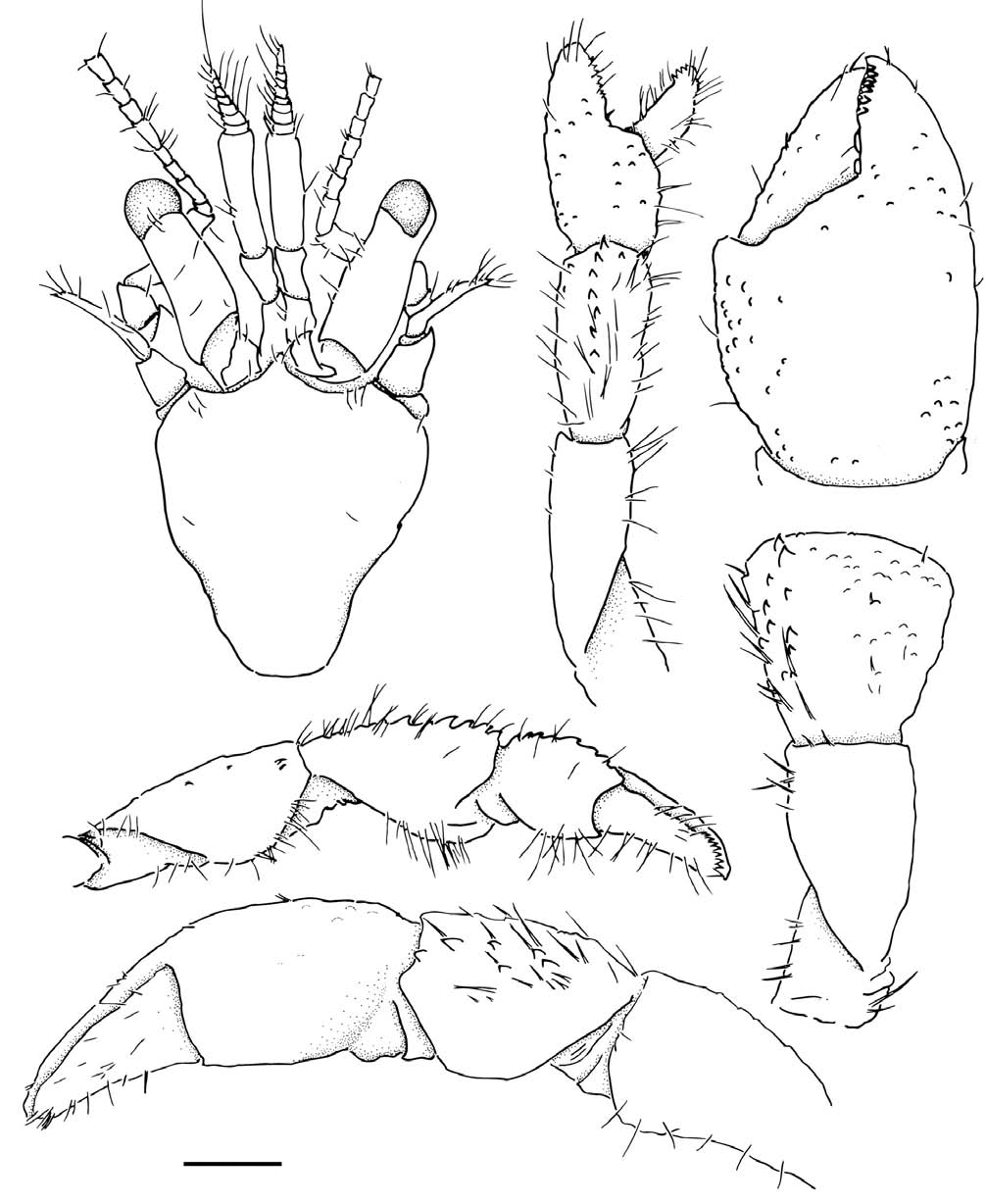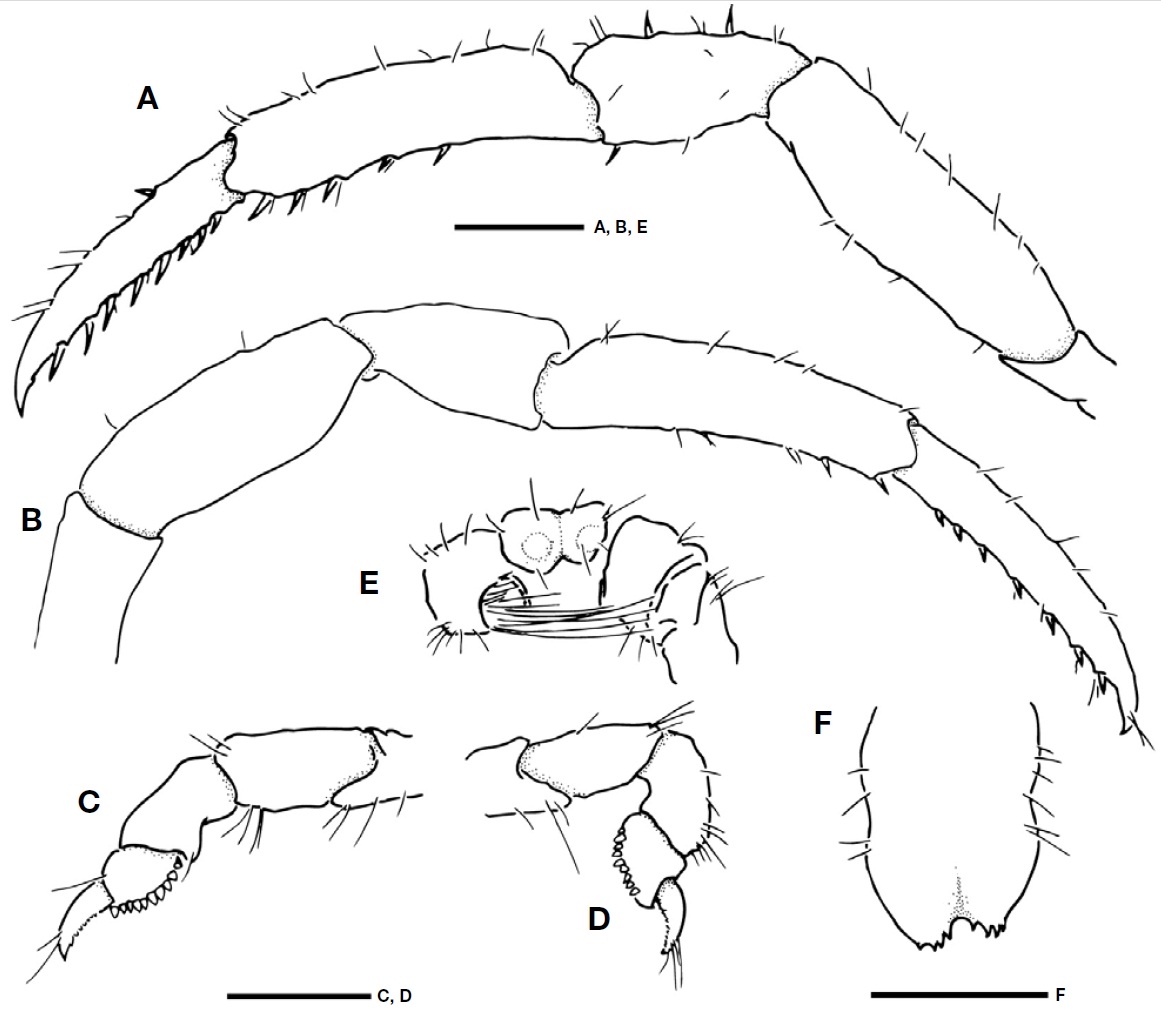



The hermit crab genus
Terminology was mainly based on that of McLaughlin (2003). Shield length (sl) is used as an indication of the size of the specimen and measured from the tip of rostrum to the midpoint of posterior margin of the shield.
Order Decapoda Latreille, 1802
Family Paguridae Latreille, 1802
1*Genus
2*
Materials examined. Korea: 1♂ (sl 1.7 mm), Busan, Isl. Hyung-ge, Sep 2009, Kim MH, by SCUBA from 10 m in depth (PUIZ 164).
Description. Shield (Fig.1 A) slightly longer than broad;rostrum triangular, distinctly overreaching lateral projections. Lateral projections obsolete, each with submarginal spinule. Posterior carapace with few tufts of short setae laterally. Ocular peduncle (Fig.1 A) 0.6 times as long as shield; each with few short setae on dorsomesial surface; corneas slightly dilated. Antennular peduncle (Fig.1 A) moderately long and slender, exceeding ocular peduncle by half length of ultimate segment. Ventral surface of ultimate segment without rows or series of short setae. Antennal peduncle (Fig.1 A) moderately short, slightly overreaching distal margin of cornea of ocular peduncles. Antennal acicle moderately short, overreaching
base of cornea, but not reaching distal margin.
Right cheliped (Fig.1 B, C, E) considerably larger than left. Chela (Fig.1 B) about 1.7 times longer than broad, subovate in dorsal view. Dactylus (Fig.1 B) about 0.6 of palm length, usually leaving narrow hiatus when closed; dorsal surface with small, simple granules and scattered very short setae; dorsomesial margin not delimited; cutting edge with row of very low, obtuse teeth. Fixed finger (Fig.1 B) with obtuse calcareous teeth at middle and row of small calcareous teeth,terminating in small corneous or calcareous claw. Palm (Fig.1B) longer than carpus; dorsal surface with scattered small granules and few very short setae; dorsolateral margin slightly delimited by row of granules extending onto fixed finger; lateral, mesial and ventral surfaces microscopically granular or nearly smooth. Carpus (Fig.1 C, E) subequal in length to merus; dorsal surface with single or double row of small spines and longitudinal row of tufts of spiniform setae mesially;all surfaces microscopically granular or smooth, lateral surface without longitudinal ridge; ventral surface (Fig.1 E) convex, with few setae. Merus (Fig.1 C, E) smooth on dorsal surface; dorsodistal margin unarmed; ventral surface (Fig.1E) smooth with some short setae.
Left cheliped (Fig.1 D, F) moderately shorter than right. Chela (Fig.1 D) about 2.5 times longer than width; Dactylus (Fig.1 D) moderately longer than palm, with sparse setae on surface; dorsal surface smooth; cutting edge with row of small corneous teeth. Cutting edge of fixed finger (Fig.1 D) with small calcareous teeth. Palm (Fig.1 D) about 0.5 times as long as carpus; dorsal surface with scattered small granules; dorsomesial and dorsolateral margins not delimited; lateral surface with very small granules; mesial and ventral surfaces nearly smooth, with tufts of short to long setae. Carpus(Fig.1 D, F) slightly shorter than merus; dorsal surface with few spiniform setae laterally; dorsomesial margins armed with small spines; mesial face smooth, with some long setae dorsally and ventrally; long setae on weakly convex ventral surface. Merus (Fig.1 D, F) smooth on dorsal surface; dorsodistal margin unarmed; ventral surface (Fig.1F) smooth, only with some short and few long setae.
Ambulatory legs (Fig.2 A, B) moderately slender, overreaching right cheliped. Dactyli 0.8 times longer than propodi, terminating in large corneous claws; dorsal surfaces each with sparse short setae; ventral margins each with row of 6-8 corneous spines. Propodi each with row of tufts of short setae and row of 2-5 corneous spines. Carpi each with usually with few short setae. Meri each with row of sparse setae.
Fourth pereopods (Fig.2 C, D) semichelate, unequal from right to left, left appreciably larger than right. Left dactylus(Fig.2 C) terminating in small corneous claw, with setae on dorsal margin; ventral margin with row of minute corneous teeth. Right dactylus (Fig.2 D) with setae on dorsal margin. Propodal rasp consisting of single row of small corneous scales.
Fifth pereopods (Fig.2 E) subequal in size; right with prominent tuft of setae nearly reaching to left coxa; left coxa gonopore partially masked by tuft of short setae.
Telson (Fig.2F) with posterior lobes divided by median cleft; terminal margin each with four small spines.
Coloration. Shield, posterior carapace, ocular peduncles, and pereopods generally whitish red. Shield and posterior carapace with scattered pink or red dots. Ocular peduncles each with brown band. Chelipeds with scattered pink and red dots; meri each with narrow brown ring on subdistal part. Ambulatory legs with brown transverse bands.
Distribution. Hyung-ge Island, Busan, southern Korea and Okinawa Island and Iriomote Island, Ryukyu Islands, southwestern Japan.
Remarks.The newly collected specimen from Hyung-ge Island agrees well with the type series of
Korean name: 1*작은참집게속 (신칭), 2*얼룩작은참집게 (신칭)


